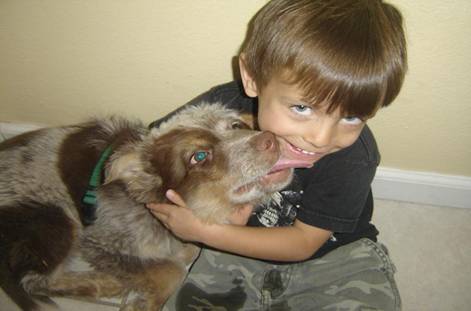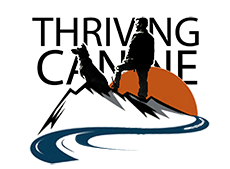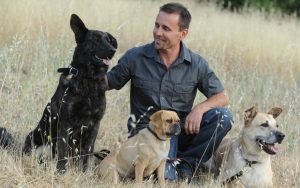Well, we’ve all seen it. That adorable little girl, who is so young that she can barely form a complete sentence, sits down on her knees to grab the cheeks of a dog while looking him squarely in the eye. We think it is so cute, especially when the dog is licking her face and wagging his tail. “Ahhhhhh” can be heard for miles. And sometimes there is no harm in that scenario. The dog’s body language will, in many cases, show us how the dog feels about having his face kneaded like a ball of dough.
 Here is a picture of my nephew, Cooper, down on the ground with his own dog giving him a big wet kiss. As you can see, the dog's ears are relaxed while he is licking Cooper's face, which is a sign that the dog is enjoying the moment. There is also no direct eye contact which can be intimidating and/or taken as a threat by a dog. The dog is lying down and not trying to escape, notice the position of the legs, very relaxed with no bracing. Actually the dog appears to leaning into the big wet kiss. Also notice Cooper's light touch on his dog's neck with the left hand and the position of his right hand (you can see it just under the dogs chin) which is ready to push the dog away when he's had enough. The dog is not being held captive.
Here is a picture of my nephew, Cooper, down on the ground with his own dog giving him a big wet kiss. As you can see, the dog's ears are relaxed while he is licking Cooper's face, which is a sign that the dog is enjoying the moment. There is also no direct eye contact which can be intimidating and/or taken as a threat by a dog. The dog is lying down and not trying to escape, notice the position of the legs, very relaxed with no bracing. Actually the dog appears to leaning into the big wet kiss. Also notice Cooper's light touch on his dog's neck with the left hand and the position of his right hand (you can see it just under the dogs chin) which is ready to push the dog away when he's had enough. The dog is not being held captive.
One Person's Kodak Moment is Another Person's Trip to the Hospital
 Now take a look at this picture. The dog is pulling his ears back and his body is not engaging; it is repelling. Both of these are signs that the dog is not enjoying the experience. Furthermore, he is feeling threatened. And what can happen when a dog feels threatened? Chomp! You guessed it. Remember what we just learned about direct eye contact? This child's eye contact could not be more direct, plus it's coupled with a grab on the muzzle. Grabbing the muzzle is a very dominating thing to do to dogs. Hopefully this is a dog that already knows this child and is used to tolerating this kind of behavior. But even still, this is a very poor practice. This dog is clearly communicating that this is not cool.
Now take a look at this picture. The dog is pulling his ears back and his body is not engaging; it is repelling. Both of these are signs that the dog is not enjoying the experience. Furthermore, he is feeling threatened. And what can happen when a dog feels threatened? Chomp! You guessed it. Remember what we just learned about direct eye contact? This child's eye contact could not be more direct, plus it's coupled with a grab on the muzzle. Grabbing the muzzle is a very dominating thing to do to dogs. Hopefully this is a dog that already knows this child and is used to tolerating this kind of behavior. But even still, this is a very poor practice. This dog is clearly communicating that this is not cool.
Who is the boss of whom?
Keep in mind that dogs generally won’t accept dominance from a child. Dogs can and should have a lower rank in the “pack” than a child but it is not natural, it has to be trained. One more important thing to note is if a dog is being loved to death by a child (pun intended) and the dog is teathered or leashed in a way that eliminates his option to flee, the dog may be instinctually on guard. This is a very important concept. We’ve all heard of the “Fight or Flight” response right? Well, if you take away the flight option what’s left? That leaves us with fight, which is one of the reasons for leash aggression.
Who's to blame?
Who do you think would get blamed if a dog bit a child for yanking its tail or squeezing its face as an act of love? Who do you think should get blamed? Would this dog be doing the right thing to defend itself by biting the child?
- If we were speaking dog than absolutely, this child needs to be corrected for rude behavior which would be a bite, most likely on the face. That’s how dogs correct each other and as noted above, dogs usually will see a child as a sibling or a subordinate, not a leader.
- On the other hand, if we’re dealing with a typical human reaction, the dog would be to blame. The dog would typically be reprimanded, potentially beaten, and maybe even locked up or put down.
- The real culprit, in fact, would be the adult taking the picture! We are a dog loving culture but as a whole don’t understand them. We expect them to tolerate a lot of things which go completely against their instincts. We correct the dog for growling but not the child for being inappropriate with the dog. We correct the dog that bites the puppy rather than the puppy that was being rude to the dog. If we are not providing the leadership, controlling the pack and dolling out the proper corrections to the proper recipients, the dog will feel a need to do the correcting themselves and they correct with their teeth.
It is really important to teach a child about dog body language but when they can barely say their ABCs this may be too much to ask.
So Here is the Solution
Take away the gray areas and don’t expect your child to know which dog is o.k. to behave a certain way with and which dog is not. It’s too confusing. You are not always around to gage dogs for your child, so it is better to error on the side of safety. As the child gets older, they can start to gage for themselves, but for now, have one set of rules that your child follows consistently:
- Teach your children the right way to approach a dog they don’t know. Hint: It is not to have the child running and flailing full speed ahead while screaming at the top of his lungs as he charges into the dog. Quite the contrary, the right way for anyone (especially children) to approach a new dog is to ignore the dog and let him come to you. In other words the best way to approach a new dog is to not approach. I repeat, let him come to you.
- Teach your children to feel comfortable asking the dog's owner if their dog is friendly and ask for permission to engage. By engage, I mean interact with the dog once the dog makes the first move. (See first bullet.)
- Teach your children to move their hands slow and low with the dog. When going to pet the dog, it's always good to move gently without sudden and jerky motions. Also, teach them to keep their hands low. For instance, rub a dog under his chin rather than coming up over the top of their heads to scratch their nose or forehead. This is a much more appropriate and safe greeting for the dog.
- Don’t bother a dog when he is eating, sleeping or injured. You remember the old saying, “let sleeping dogs lie”… they aren’t kidding.
- A child should never look a dog squarely in the eye. It is a threatening gesture for animals (and sometimes even for humans). Rocky did that to Mr. T. in Rocky III (the eye of the tiger) and we all know what happened to him! Mmm-hmmm.
- Don’t allow your children to pull a dog’s tail. If the child is behind the dog (never a good way to approach a dog by the way) and teases him by pulling his tail, the dog can startle and easily turn and correct (bite) the child for bad behavior. And let’s face it. It’s mean to pull a dog’s tail.
- No poking and prodding. Children will often poke a dog's eyes or mess with their ears. Dogs do not like this and may bite, especially if they can’t get away.
- No hugging. Humans love to hug but dogs can feel threatened by this. (This one may be tough, but remember, we are eliminating gray areas. May be fine with your little fluffy lap dog, but a bad practice for the little ones. They may try this on the wrong dog.)
So, How Do You Teach a Child How to Behave with Dogs?
My wife published a book titled “What's Up Willie? The Birthday Puppy!“. This story teaches children how to safely interact with dogs as well as how to be a responsible dog owner. Trust me, they’d rather learn from a cute little cartoon boy and his dog than you. They’ll believe what Willie tells them and then you can hang the “What would Willie do?” question over them when they are not complying with the dog rules he’s learned.
Chad Culp–Certified Dog Trainer, Behavior Consultant, Certified Holistic Chef for Animals
Copyright 2005-2013 Chad Culp, Thriving Canine. All rights reserved. Chad@ThrivingCanine.com
Check out www.ThrivingCanine.com for more free articles, videos and sign up for the weekly newsletter.
Subscribe to Thriving Canine YouTube Channel
Apply for membership of the THRIVING CANINE UNIVERSITY Facebook group. (please read the rules before joining)



